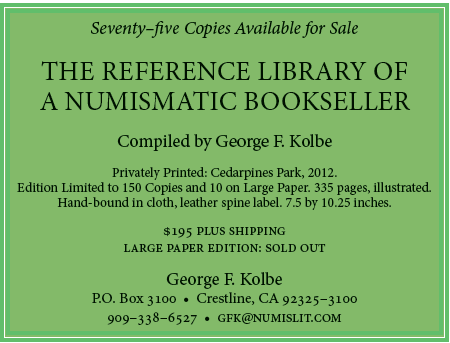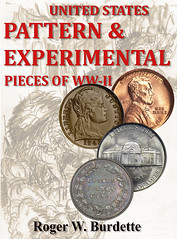
PREV ARTICLE
NEXT ARTICLE
FULL ISSUE
PREV FULL ISSUE
BOOK REVIEW: PATTERN AND EXPERIMENTAL PIECES OF WW-II
I'm no expert in WWII pattern coins, but Roger certainly is - he's clearly done his homework on this book, to the benefit of the rest of us in the hobby. Most of what readers will find in this book is new information, the product of Roger's many hours of research in national, local and corporate archives. He even placed advertisements in communities where workers who produced the patterns would have lived. While Roger is the first to admit that this first edition is an incomplete work in progress, it clearly stands head and shoulders above what little has been published before on this narrow topic. The 188-page softbound book was produced in a limited edition of 500 copies. It opens with Roger's Introduction followed by the extensive Acknowledgements, which include nods to the major auction houses, dealers, collectors and researchers who assisted his study, including a host of E-Sylum regulars including Augsburger, Bowers, Bressett, Ginsburg, Julian, Kraljevich, Lange, Lustig, Teichman and Orosz. The first chapter provides an overview of the experimental coins, Mint processes and procedures, and the corporate participants in the study. Numismatists will be familiar with the names of Mint Director Nellie Tayloe Ross and engraver John Sinnock. Other names, such as the Patent Button Company of Knoxville, TN will be new to many readers. One fact that comes up early in the book is that the first wartime material to be removed from U.S. coinage was in fact tin. Some 93% of all 1942-D cents were made with only the tiniest trace of tin in a nod to the prevailing coinage laws which specified tin, but didn't specify an amount. So how can one tell the difference? The remaining 7% of 1942-D cents were made from existing stocks of planchets on hand before tin was removed from the mix. Roger has identified three different reverse dies for the experimental plastic cents of 1942. Of course, mint-produced coin dies could not be used directly, but apparently mint officials were clueless. Coin dies could not be used in either injection or compression molding: "they were the wrong size and lacked heating channels, sprue and runner connections necessary for molding. All plastics companies had to remake the mint dies so they would work in their molding machines" (p19). Quite a number of contractors large and small were involved with the experiments. In addition to the Patent Button Company, Westinghouse, DuPont, General Electric, Monsanto, the Auburn Button Works and the Prophylactic Tooth Brush Company were among the contractors. The materials involved would be even less familiar to numismatists, including "Tenite", "Fibestos" and "Plastacele". Chapter Two is an extensive compilation of information about the companies involved in the experiments, with significant contributors separated from the rest of the pack. Included are quotes and excerpts from their correspondence with the Mint. All references are clearly footnoted. Chapter Three is primarily a catalog of experimental cents, but it is prefaced with a discussion of the general characteristics of the pieces, which is important to the catalog's organization. Most of the images are photos of actual specimens. Other entries have no image. But for some, Roger has created realistic artist recreations based on the descriptions found in his research. One such recreation is this "War Series" cent shown on the book's cover. Chapter Four addresses all of the replacement materials considered for the cent, while Chapter Five looks at the 1942 experimental five cent pieces. The Mint handled experiments for the this denomination itself, so there is no outside documentation to be had. And given the rush of war, apparently not much internal documentation was generated either. The first experiments were in November 1941, when eight coins were produced on stainless steel planchets. Other experiments with various metals ultimately resulting in a decision to use the silver alloy known today for the "War Nickels". The book is completed with a short Chapter Six on the Sources of Experimental and Pattern Pieces, eight appendices and a bibliography. The Appendices include a good deal of interesting and useful material, such as a complete National Bureau of Standards report on the plastic tokens, a copy of the December 18, 1942 Public Law Authorizing Changes to the Minor Coins, and a very useful table and technique for identifying the precise color of a plastic piece. So what happened to the pattern and experimental pieces that were made? Roger's review of the records shows that instructions to return and destroy the pieces were followed incompletely if at all. "The outside contractors paid little attention to tracking experimental pieces. They were after all, not coins and had no statement of value. Samples were forwarded to the Mint, but most others came to rest in a trash dump or incinerator. Employees likely took home samples to show the kids and from there, examples could have ended up in cigar boxes, taped in photo albums, or used as game counters or even buttons." (p115) Despite this "leakage" from the Mint, very few of most types of pieces were made in the first place, and most of those were later destroyed, including the stainless steel nickels mentioned above. This makes for some great rarities. The population table on p170 shows that many are unknown, many others may be unique, and none has an estimate population of more than 50 pieces. Since few of us are likely to ever own one of these rare experimental pieces, why buy the book? Well, few of us will own an 1804 dollar either, but that doesn't keep me from owning multiple books on them. This is pure numismatic history, and a key piece of the puzzle of 20th century U.S. coinage. I highly recommend Roger's book to E-Sylum readers, who include, as I often note, "numismatic bibliophiles, researchers, writers, and just plain collectors." See the earlier E-Sylum article for price and ordering information. To read the earlier E-Sylum article, see: NEW BOOK: PATTERN AND EXPERIMENTAL PIECES OF WW-II (www.coinbooks.org/esylum_v16n05a05.html)

Wayne Homren, Editor The Numismatic Bibliomania Society is a non-profit organization promoting numismatic literature. See our web site at coinbooks.org. To submit items for publication in The E-Sylum, write to the Editor at this address: whomren@gmail.com To subscribe go to: https://my.binhost.com/lists/listinfo/esylum All Rights Reserved. NBS Home Page Contact the NBS webmaster 
|
